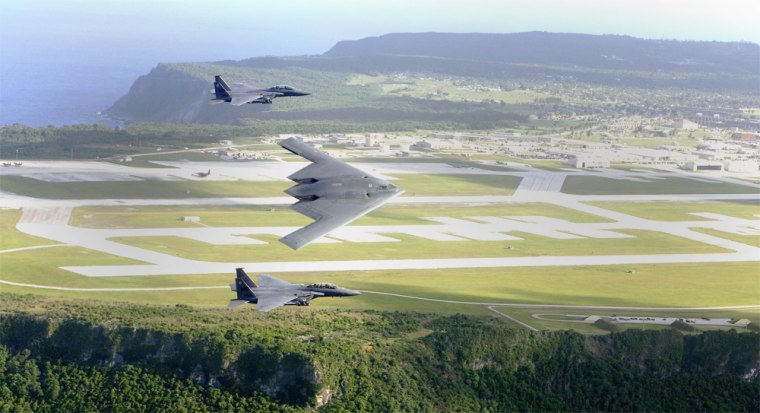In the midst of a recession that has cost millions of Americans their jobs, a massive military construction project on the U.S. territory of Guam is provoking a unique debate that boils down to this deceptively simple question: Should the government be more concerned about creating jobs or minding the taxpayers’ money?
At the center of the debate is one of the biggest construction projects on the U.S. government’s “to do” list: a roughly $15 billion military base expansion that is expected to require some 20,000 construction workers starting next year. Guamanian Americans will fill some of the jobs, but most are expected to go to foreign workers from the Philippines, China, and South Korea.
If it hadn’t been for the recession and climbing joblessness in the United States, the project might have gone forward in obscurity — as often happens on the remote Pacific island.
But a Hawaii lawmaker is challenging the rules that govern the project, which includes the construction of the military facility and housing for 8,000 U.S. Marines and their families. Rep. Neil Abercrombie, D-Hawaii, inserted a provision in the 2010 defense appropriations bill to require 70 percent of the project jobs go to residents of Guam or the U.S. proper. And, in an attempt to lure more stateside American workers to jobs in the far-flung territory — a seven-hour flight from Honolulu — the amendment would roughly triple hourly pay on the project to match Hawaii’s wage levels.
“It’s using U.S. taxpayer dollars to build a U.S. military base on a U.S. territory,” said Dave Helfert, Abercrombie’s press secretary. “Why would we not use those dollars to put as many American workers to work as we can, especially in the construction industry, which has been hit so hard?”
The House approved the Abercrombie amendment in June. But the Senate version does not address the issue and Democratic Sen. Daniel Inouye, Abercrombie's fellow Hawaiian and influential member of the Senate, opposes the measure. The two chambers of Congress are now in conference hammering out the details of the 850-page defense bill, and a final version is expected by mid-October.
Whether or not the amendment remains in the final version, it has stirred strident debate in both Guam and Washington.
While enthusiastically embraced by labor advocates, the Abercrombie amendment has run up against a long tradition in Guam of relying on imported construction workers to bolster the small local workforce, a practice that has kept construction wages low. Guam contractors and government leaders in Guam have slammed the proposal as unwanted meddling in the local labor market. The Pentagon is against it because it would add billions to the cost of the project, which was estimated based on prevailing wage levels for construction jobs in Guam — just half the U.S. average.
Out of Japan
The Guam buildup is part of U.S. military realignment in the Pacific resulting from the growth of anti-American sentiment in Japan, where the United States has maintained large bases since the end of World War II. A series of U.S. military accidents that caused civilian deaths and the rape of a Japanese schoolgirl by American servicemen in the 1990s sparked a movement to expel U.S. forces from Japan. In 2006, after prolonged negotiation, Washington and Tokyo agreed to relocate some air bases farther away from population centers in Japan and move the U.S. Third Expeditionary Marine Force to the U.S. Pacific territory of Guam.
The base build-up in Guam will turn the tiny island — currently home to Andersen Air Force Base — into a major hub of U.S. military operations in the Pacific, with facilities for submarines, aircraft carriers, and Navy Special Operations forces.
Within the overall $15 billion project, Japan has agreed to chip in $6 billion for housing and facilities. Twenty-three thousand active military personnel and family members will move to Guam as part of the realignment. Japan agreed to cover $6 billion to help build housing and facilities for some 23,000 active military personnel and family members who will move to Guam as part of the realignment.
Labor costs for the project were determined under a formula laid out in the Davis-Bacon Act, using a rate scale for workers based on local income levels. In Guam, those rates are low — too low to attract American workers from the states, Abercrombie argues.
Under his proposal, a carpenter would be paid about $36 an hour – the going rate for federal projects in Hawaii — rather than the $11.70 that the Pentagon budgeted for the construction in Guam.

At these rates, Abercrombie says, stateside construction workers will be willing to travel to Guam for jobs. According to the Associated General Contractors of America, the U.S. construction industry lost 1 million jobs in the year ending in August 2009. Arizona suffered the biggest percentage decline — losing 50,000 construction jobs, or nearly 27 percent of its total.
Hawaii lost about 5,100 construction jobs — 13.6 of its total — over the same period.
Abercrombie's detractors have portrayed his Guam proposal as pandering to workers back home as he prepares to run for governor of Hawaii.
But Helfert, Abercrombie’s spokesman, said the amendment was “not just aimed at Hawaii workers. It makes sense if you have people out of work to create jobs for them — whether it’s in California, Nevada, Arizona or Oregon.”
Tight budgets, tough talks
Even though the Abercrombie proposal can be cast as stimulus money, it would add to costs at a time when the U.S. is struggling to contain military spending while fighting two foreign wars and contending with growing demand for veterans’ services.According to the Congressional Budget Office, the wage hike would drive up the Guam project by about $10 billion.
That’s a change some think could complicate already prickly talks over the military realignment with Japan’s newly elected leaders, who have taken a more nationalistic stance and threatened to withdraw financial and logistical support for various U.S. military operations.
“Given all that is going on … spending an extra $10 billion seems very unlikely,” said Todd Harrison, a fellow for defense budget studies at the Center for Strategic and Budgetary Assessments in Washington, D.C. “Also, we are in this jointly with the Japanese. If we throw in some requirement to pay these higher wage rates and 70 percent of the labor force has to be U.S. citizens that could cause the Japanese to reconsider their role.”
The move to bring in U.S. workers by raising wages has met with fierce resistance from contractors in Guam, who benefit from the ability to use temporary foreign workers under the H2B visa program. Since the 1950s, most major construction projects in Guam have employed foreign workers — primarily from the Philippines — who live in barracks provided by contractors and then return home when the job is done. There is no union for construction workers in Guam, nor is there a system of unemployment to assist local workers during dry spells — both factors in a persistent shortage of construction workers in the territory.
“The temporary workers and H2B workers really fit for Guam,” said James Martinez, president of the Guam Contractors Association.
At the moment there are about 1,800 “guest workers” in Guam, or about a quarter of the total construction workforce, according to the Guam Department of Labor. That number swelled to about 6,000 during a construction boom fueled by Japanese investment in the 1990s, and a U.S. military official visiting Guam last year predicted that about 12,000 temporary workers would be needed to work on the base project. Recruiters are already active in the Philippines, with some trumpeting up to 50,000 job opportunities on the base project, and other construction on Guam sparked by the U.S. buildup.
“Certainly there’s no closed door for workers from the U.S.,” said Martinez. But he said his organization opposes putting a quota for American workers or hiking wages to assist unemployed construction workers elsewhere in the United States. “Unfortunately we can’t be the answer to the economic woes of Hawaii or the rest of the U.S.,” he said. “We don’t want to be forced to pay wages that don’t fit our economy.”
‘Effects... could be disastrous’
Guam Gov. Felix Camacho and the territory’s sole representative in Congress, Madeleine Bordallo, also oppose the Abercrombie amendment.
“If wages were to go up on military construction projects, we risk taking government of Guam employees out of their jobs and working in the construction industry,” said Matthew Herrmann, press secretary for Bordallo. “The socioeconomic effects on Guam could be disastrous.”
Supporters of Abercrombie’s proposal also argue that the wage increase is long overdue.
“The business community in Guam has consistently used H2B workers to drive down wages in Guam,” said Matt Rector, a territory senator who heads Guam’s labor committee as well as the Guam Teacher’s Union, which represents public sector workers. “Would (the Abercrombie proposal) destroy Guam’s economy? No, it would fix Guam’s economy. The economy is so depressed.”
The average income in Guam is about $28,000 a year, according to Guam’s Department of Labor, while the island’s cost of living is higher than that of Washington, D.C. Half of the population earns under $10 an hour, and about one-fourth of the population is on food stamps.
Penny wise, pound foolish?
“It may cost more in the short term, but all that money is coming back into the U.S. economy, either reducing (poverty) in Guam, or back in continental U.S.” said Rector. To reject it, he says, would be “penny wise and pound foolish.”
Gary Hiles, economist for Guam's Department of Labor agrees that bringing in U.S. workers at higher wages would cause some hiccups in the local economy.
But he notes that there are advantages to hiring Americans over foreigners to do the work on U.S. bases: “National security is one of them. The (higher) quality of workmanship is another.”
And paying higher wages also would bolster the local economy, he says, more so than hiring foreign workers who typically send much of their earnings out of the country — and generate additional tax revenue for badly needed infrastructure upgrades.
“I think the U.S. workers would buy and rent cars, go to restaurants and hotels and barbershops — a whole array of things that (foreign) workers in barracks don’t do,” Hiles said.
“The additional investment to make Guam jobs attractive to U.S. citizens may well be a cost effective economic stimulus policy in putting unemployed U.S. construction workers back to work,” he added. “Certainly, construction work could be done at lower cost on the U.S. bases on Guam by primarily importing temporary foreign labor from Asian countries, just as it could be done cheaper on U.S. bases in Hawaii, California or any other state. ... But is that the policy that the federal government wishes to pursue?”
